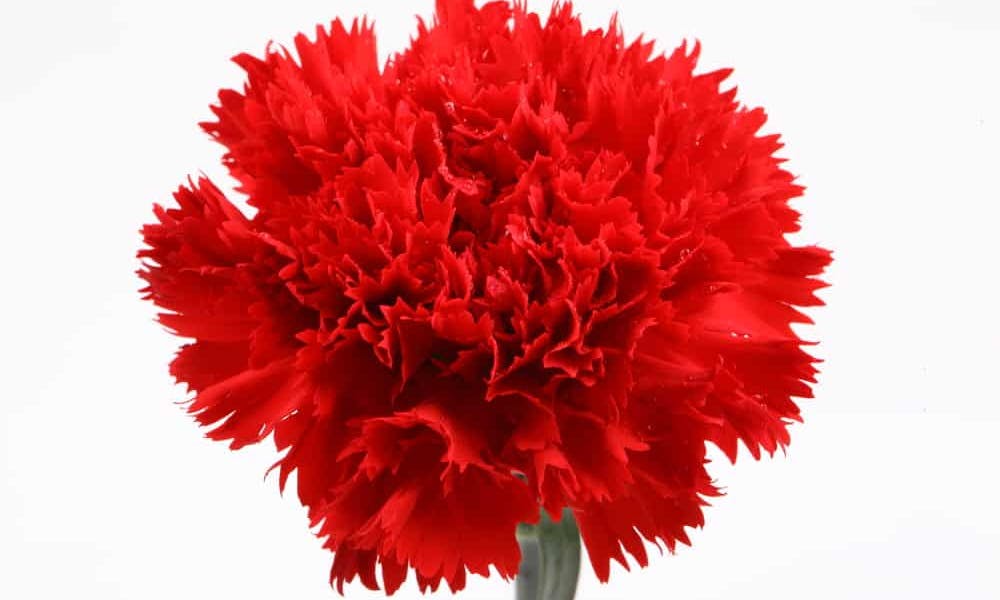Carnations come in hundreds of varieties and in many of the colors of the rainbow. They bring the hues of summer to your garden as well as to special occasions. Cut flowers last for weeks making them a popular choice for boutonnieres, bouquets, and spring floral arrangements.
As you read this, you can learn the following:
- General Characteristics
- History
- Modern Meaning and Symbolism
- Significance in Culture
- Care
General Characteristics
The carnation is a perennial flower that has fringed petals in a variety of colors such as pink, red, white, purple, green, and yellow. The blue and purple colors did not exist until bioengineering took the genes from petunias and snapdragons to create the new color. The flowers have a sweet, spicy scent.
Carnations have three main body types. The spray type of flowers have clusters on different stems. The large flower heads grow one flower per stem and are the ones most used in bouquets. Finally, the dwarf carnation, which has multiple small flowers on one stem.
Carnation plants, on average, reach 31 inches tall. The stems produce greyish-green leaves and notched stems.
History
The carnation has been cultivated for the last 2,000 years. The wild carnation is native to Greece, Italy, Spain, and other Mediterranean countries.
The carnation was first mentioned in Greek literature 2,000 years ago. The goddess Diana fell in love with a shepherd. He did not reciprocate her love and affection, which angered Diana. She removed his eyes and threw him to the ground. Myth has it that carnations sprouted from his remains. It became the chosen flower for the crowns and garlands used in Greek ceremonies.
In Christian belief, when the Virgin Mary witnessed Jesus carrying the cross, she cried. Carnations grew where her tears fell. Pink carnations have come to represent a mother’s undying love.
The fragrance of carnations has been used for vinegar, sauces, and salads. In Elizabethan times, carnations were used to make spiced wine and beer. The petals were also crushed and used for tea.
Modern Meaning and Symbolism
There is a whole bouquet of meanings and symbols associated with carnations. Predominantly, carnations are associated with love, fascination, and distinction. They not only represent feelings and emotions but mark special occasions as well.
During final exams at Oxford University, a white carnation is worn on the lapel signifying that the wearer is taking their first exam. All exams thereafter, the wearer dons a pink carnation. To celebrate the final exam, the student wears a red carnation.
The following colors are associated with specific emotions and sentiments:
- Red- profound love and affection
- White- pure love and good luck
- Striped- a regret that love cannot be shared
- Purple- a traditional funeral flower given as condolence
- Yellow- disappointment and rejection
- Pink- a mother’s love
Significance in Culture
As with a lot of flowers, carnations hold a significant place in the culture of many countries.
In 1601 Shakespeare wrote in “A Winter’s Tale,” ‘The fairest o’ the season are the carnations.’
Carnations are the topic of many songs. For example, the song “White Sport Coat,” describes the wearer having a “white sport coat and a pink carnation.” The narrator in the classic song “American Pie” also has a pink carnation, “ a lonely teenage bronkin’ buck/ with a pink carnation and a pick-up truck.” Another reference to carnations is found in the lyrics of “Carnation for Rebu,” “A carnation for Rebu and a sweet song/ to serenade my lady all night long.”
Artists too have used carnations as a subject in their paintings. Edouard Manet painted “Flowers in a Crystal Vase,” displaying a bouquet of mixed flowers, which includes carnations. Pierre-August Renoir painted “Spring Bouquet,” detailing a spring arrangement with carnations bursting from a porcelain pot.
Carnations are a major floriculture crop found on the islands of Maui, Ohau, Kula, and others. They are the principal flower used in many leis in Hawaii, which are used for May Day celebrations and graduations.
The scarlet carnation is the state flower of Ohio. It honors William McKinley who was not only the governor of the state but the President of the United States who was assassinated in 1901. In remembrance of McKinley, who often wore a scarlet carnation, the scarlet carnation was adopted as the state flower.
The carnation is the national flower of Spain, Monaco, and Slovenia.
The carnation is the birth flower for those born in January.
Green carnations not only represent Saint Patrick’s Day but represent Oscar Wilde, an Irish playwright and poet. Honoring their namesake, the Oscar Wilde Tours company adopted the green carnation as its symbol.
Care
Carnation plants require well-drained soil and full sun for at least four to five hours a day. Soil should be deep and moist. Be watchful for yellow leaves, as they are an indicator that the plant has been overwatered. Removing dead blooms immediately promotes continuous bloom. To harvest carnations, be sure to fertilize plants. At the end of the season, cut the plant level with the ground.
For indoor arrangements, first cut the stems at a 45-degree angle while holding it under running water. This purposeful cut keeps the stem open and facilitates water absorption. Before arranging, clean the vase or container thoroughly with warm water and a delicate detergent. Then add fresh water and a floral preservative; sugar works well for this purpose.
As you place the carnations in the vase, remove leaves that fall below the waterline. Recut the stems every couple of days, cutting just above the node. This allows the stems to draw water more easily. Cloudy water indicates it’s time to change the water. With basic care, arrangements can last two to three weeks.
Conclusion
Carnations are a popular choice for any celebration. A well-placed boutonniere or corsage adds a classy final touch to the occasion. Arrangements made with carnations last for a long time and remain fresh looking and vibrant with minimal care.
